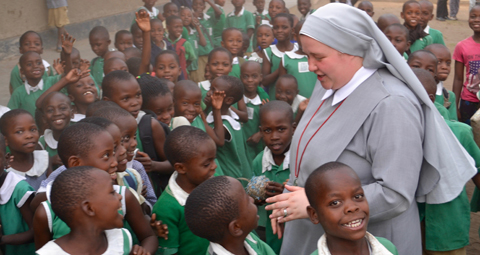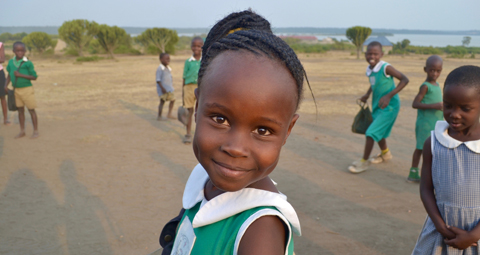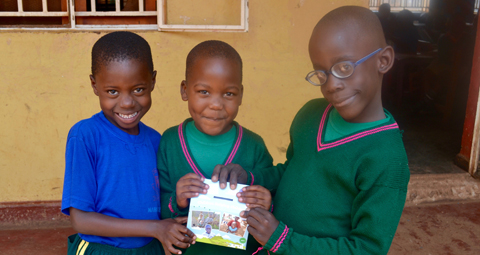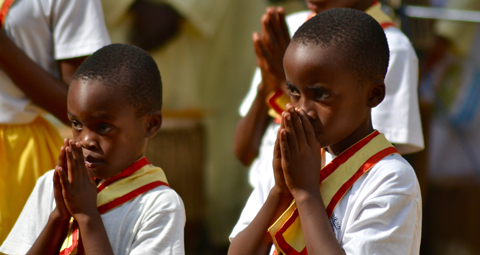August 11 | ![]() 0 COMMENTS
0 COMMENTS ![]() print
print

Into Africa: a Faith mission to Uganda
Missio Scotland’s communications officer GERARD GOUGH recently visited Uganda to learn about the Catholic charity’s projects. Here is his vivid and personal account of the incredible work funded by your donations. - BY GERARD GOUGH
As our plane descended into Entebbe Airport, I rubbed the sleep from my eyes and afforded myself a look out the window and was instantly struck by just how verdant Uganda looked from the skies.
In my role as communications officer for Missio Scotland, I visit schools and explain to them why each colour on the Mission Rosaries has been chosen for each continent. I perhaps should have taken a photo there and then and I would have been able to easily explain to them why Africa is green
So here I was, excited to be embarking upon my first mission trip since joining the charity back in April 2016. Unfortunately my luggage hadn’t joined me, having only made it as far as Dublin!
Nonetheless, the bright smile of the face of Sr Stella Niwagira as she greeted us at the arrivals gate helped evaporate our slightly dampened spirits. That warmth and friendliness was to be replicated in the days to come by the clergy, religious and lay people we met.
We were here in Uganda to visit some of the plethora of projects that the Pontifical Mission Societies (PMS)—of which Missio Scotland is the Scottish branch—supports throughout the country.
The trip would see us take in novitiates, schools, a religious printing press and even an ordination, as we spent time both in and around the capital city of Kampala and further afield in the Diocese of Kasese, which lies to the east of the country, close to the border with the Democratic Republic of Congo.
My first time in the African continent certainly saw me covering the miles and it would be a trip that would reinforce why Missio Scotland is one of the most important Catholic charities and why Scottish Catholics should be fulsome in their support for it.
Our first assignment involved visiting the Sisters of the Immaculate Heart of Mary Reparatrix at their Novitiate in Ggogonya. After welcoming us with song and music, we had breakfast with the sisters and interviewed both them and some of the novices.
These interviews were eye-opening. They provided a fresh insight into the crucial role that the Society of St Peter the Apostle (SPA)—one of the societies that forms part of the PMS—plays in supporting the formation of these religious sisters.
“I am a direct beneficiary of Missio,” Sr Jane Francis explained. “They sponsored my studies. You can’t talk about Missio enough because even these Sisters’ formation is sponsored by Missio. I don’t think we could do without their support.”
The Sisters spoke with such eloquence and poetry when describing why they chose to answer God’s call and take up their vocation. More often than not it is derived from a strong sense of Faith within the family unit and inspirational persons from within the clerical and religious communities.
This was similarly evidenced at our next stop, Kisubi Minor Seminary, where we also spoke to some of the students, one of whom had lost his father at a young age and was cared for by a priest. These schools, naturally, aim to provide fresh priestly vocations for the Church and the young men attending it were also mindful of the support provided to them by the SPA.
Although not every student at Minor Seminaries goes on to become a priest, the three students we spoke to intended to do so.
All were grateful for the excellent standard of education they received there and explained that many students from the school go on to play important roles in both religious and civic society in the country, even if they don’t follow a vocation.
The realisation that by donating to Missio Scotland and supporting schools like this, we are not simply helping to provide the Church with priests, but we’re also creating leaders who will assist the development of a nation, was a powerful one.
We briefly attended a formation course for second-year novices and the number of attendees was testament to the strength of vocations in the country, which would be re-emphasised later in the trip.
We also visited a religious printing press, formerly run by the Sisters of St Peter Claver but now run by the Archdiocese of Kampala. It was a visit that saw Sr Stella fondly reminisce on her early days as a religious that were spent here.
The printing press is still the biggest in West Africa, producing a wealth of religious materials in the languages of the Ugandan people and those of other African countries.
The Association for the Propagation of the Faith (APF), part of the PMS, supports this work, which emphasises just how diverse the projects that we fund are.
A busy schedule in and around Kampala concluded with a visit to the Mulago School for the Deaf, founded by The Spiritan Fathers who came to work in the parish in the early 1980s.
As we made our way around the school, we were made aware that it not only provides education for these children—at a yearly cost of $300 per child—but it also feeds them and gives them board too. Most importantly, however, as told to us, these children—who were often previously seen as an unwanted burden—are given their human dignity back.
Indeed, some of the teachers at the school were themselves deaf and others who had passed through the school were helped to find gainful employment, with one story, in particular, recounted to us about former pupils who had set up their own business making yoghurt, which is currently supplied to the school today.
“These children are created in the image of God,” Fr Nicholas of the school explained. “So we need to make sure that we give them a kind of holistic formation in their lives.”
If ever evidence that donating to Missio Scotland is all-encompassing was needed, this particular visit provided it. These donations ensure the creation of new parishes, the erection of new parish buildings, support for the formation of the priests and for the children who are educated at the school, as well as helping to maintain and expand the school if needs be—that is truly inspirational.
A bumpy seven-hour journey to the east of the country—with a bit of baboon spotting thrown in for good measure—saw us arrive in Kasese Diocese, where our first port of call was St John the Evangelist Minor Seminary in Kiburara.
Its rural setting, in the shadow of the Rwenzori Mountains, was stunning, but little did we know that its beauty had been interrupted by a harrowing attack on the school by Muslim extremists in 1997, which saw farmers and eight students from the school killed.
Many of the students were caught in the gunfire that night, one of whom survived his injuries and is now a priest.
In total, 19 students were kidnapped by the extremists, with 11 eventually escaping to safety. Some suffered severe trauma in the wake of the attacks and the school worked to help them find employment in a brick factory after they had left school, to help bring some stability to their lives.
On a happier note, during the tour we were able to see the fruits of Missio Scotland’s labours: running water.
Thanks to your donations, we were able to provide the pipeline to bring the water from the river to the school itself, which has dramatically improved the life of the staff and students there.
“Water projects touch me the most,” Sr Stella said. “This one was much-needed and a great achievement, but another that sticks in my mind relates to the Diocese of Masaka—traditionally a very dry area. Through Missio, we were able to bring water to every parish in the diocese and every school. Because of Missio, Masaka now has life.”
Our next stop in Kasese Diocese was Katwe, where we met with children who were members of the Holy Childhood Association, what we more commonly know in Scotland as Missionary Children.
From the minute they came into view their vibrancy and enthusiasm was so infectious and their numbers were testament to the strength of that particular society in Uganda.
What was shocking to hear from them during a brief Q&A though was how they had almost been pre-conditioned to believe that a white person’s blood, skin and eyes were superior to their own. As individuals and communities, we still have work to do, it seems, to make these children feel properly valued and imbued with human dignity.
A little further down the road we stopped off at St Jude’s Primary School and the interaction with the children there was uplifting. The teachers at the school welcomed us warmly and gave an insight into how money from PMS worldwide had helped them to build their school in a physical and spiritual sense.
During out visit to Kasese, we were invited to attend the ordination of two priests and three deacons, which was a truly colourful, spectacular and spiritually uplifting experience.
There was joy in abundance for not only the clergy and religious and the family and friends of the ordinands, but the entire diocese who shared in their special day.
One startling aspect of the ceremony was the gifts given to the newly ordained priests, two motorcycles, which struck our group as extremely practical given the difficult terrain in the diocese.
Those gifts underlined just how important it is for newly ordained priests in Uganda to make an instant connection with their parishioners, no matter how far afield they may be. And given the shouts of joy and the cheers, it’s a relationship that the parishioners themselves seem keen to establish quickly too.
After the ceremony itself, we spoke with a number of the major seminarians, who— like the novices and minor seminarians back in Kampala—spoke of the existence of a strong Faith in the family unit and also the important role that clergy and religious had played in influencing their vocation.
That was perhaps even more poignant given that we were at an ordination. The Bishop of Kasese—who was delighted to have us among the congregation on the day—met with us to tell us that after the ordination and also give us a fuller picture of the diocese.
As we wound our way back to Kampala, our final stop was a visit to the Nsambya Babies Home, which was run by the Sisters of the Immaculate Heart of Mary Reparatrix, whose novices we interviewed at the beginning of our trip.
This was a nice addendum to this visit as we not only learned that these Sisters were running this home far better than it had previously been operating, but also it gave us a chance to see the Sisters carrying out their mission in a very specific way.
“These Sisters are making a big difference to these children’s lives,” Sr Stella said. “The children receive a lot of love from the sisters and are so comfortable with them. The children don’t want for anything.”
The visit reinforced the fact that our religious are there for people at the very beginning and at the very end of life and that thought and the sight of the Sisters with the babies themselves, were both incredibly humbling.
I packed a lot into my first trip abroad with Missio Scotland and after having spoken about the colossal amount of projects that we support all over the world to Scottish audiences, it was a privilege to see them at first hand and experience the universality of our Church.
In October—Mission Month—I’ll endeavour to provide you with a more in-depth insight into these projects and further explain just how important supporting Missio Scotland is and the significant impact that your donations to the Pope’s own charity—the official mission aid agency of the Catholic Church—has in people’s lives worldwide.
– To learn more about the work of Missio Scotland, contact [email protected], or visit: www.missio.scot, www.fb.com/missio.scot or follow on Twitter @Missio_Scotland. To donate to Missio Scotland, visit: www.missio.scot/donations, call: 01236 449774, or send donations to: Missio Scotland, St Andrews, 4 Laird Street, Coatbridge ML5 3LJ.














